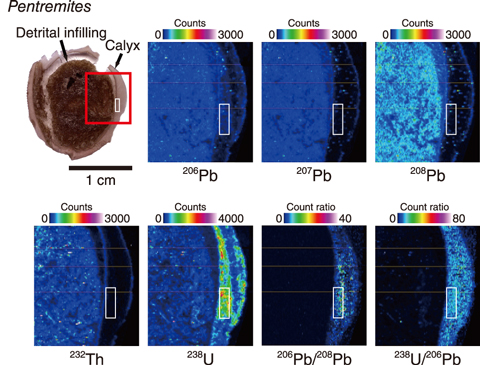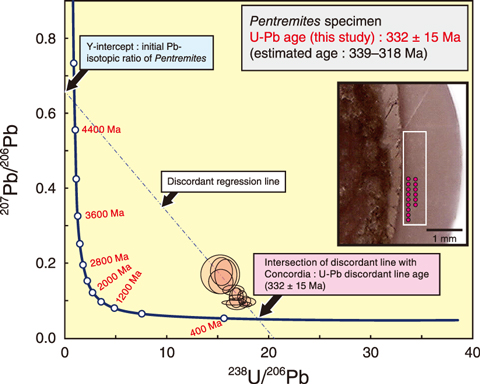
Fig.8-19 Elemental imaging map of the Pentremites sample

Fig.8-20 The dating result of Pentremites sample (Concordia plot)
Because calcium carbonate (hereinafter, carbonate) is as common filling mineral in rocks, the internal zoning of precipitation age, the chemical composition, and the carbonate’s crystallographic structure offers a wide-use indicator to reconstruct past environmental variations. Chronological studies of fracture-filling carbonate in rocks can provide precious geological information about groundwater flow and fault movement in geological history.
As carbonate minerals often form a microscopic chemical zoning structure during growth, high spatial resolution is necessary to analyze and date these solid samples. Therefore, a uranium (U)-lead (Pb) carbonate dating method was developed using laser ablation-inductively coupled plasma-mass spectrometry (LA-ICP-MS). Difficulties applying LA-ICP-MS U-Pb dating to carbonate samples have been shown to include a lack of an international standard for in-situ dating and of a methodology for selecting suitable areas for dating because of the low U (parent nuclide of U-Pb systematics) concentrations.
Quantitative two-dimensional imaging maps of U, thorium (Th), and Pb isotope abundances of the carbonate samples were obtained using a LA-ICP-MS imaging technique to select suitable areas for dating (Fig.8-19). A carbonate reference material, named WC-1 and collected from marine calcite cement from the western side of the Delaware Basin in New Mexico, USA, was used for LA-ICP-MS U-Pb dating based on previous research (*). To check the validity of the proposed dating technique, a well-preserved calcareous Carboniferous fossil specimen, Pentremites, (collected from the strata of the Chesterian age, from mid-Mississippian to earliest Pennsylvanian, in northeastern Oklahoma, USA, corresponding to an estimated age of ∼339 to ∼318 Ma), was dated.
The U-Pb age of the Pentremites sample was dated 332 ± 15 Ma (1σ), corresponding well to the age range of this specimen (∼339 to ∼318 Ma) (Fig.8-20). Thus, the proposed LA-ICP-MS dating method was successfully used to date the carbonate sample. Additionally, an examination of robust ICP condition was performed. It may be suggested that we do not need to prepare a carbonate reference material such as WC-1 under the condition to introduce nitrogen (N2) gas into ICP.
Future work will aim to improve the analytical precision and validate the applicable age range to apply the proposed dating technique to research the long-term stability of the geological environment.
This study was part of the result conducted “R&D program supporting the development of technology for geological disposal of high-level radioactive waste”, and supported by the Agency of Natural Resources and Energy (ANRE), the Ministry of Economy, Trade and Industry (METI), Japan.
*Roberts, N. M. W. et al., A Calcite Reference Material for LA-ICP-MS U-Pb Geochronology, Geochemistry, Geophysics, Geosystems, vol.18, issue 7, 2017, p.2807-2814.